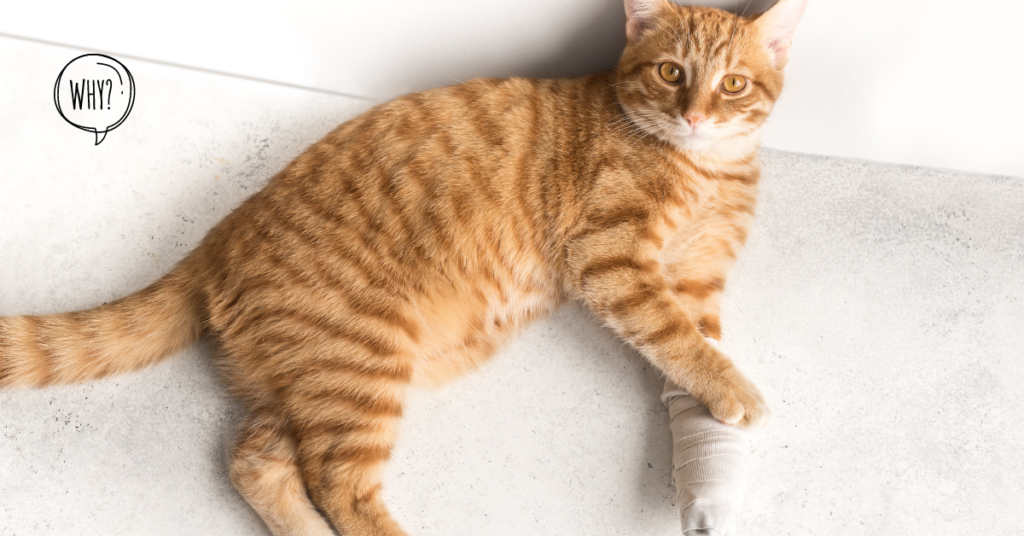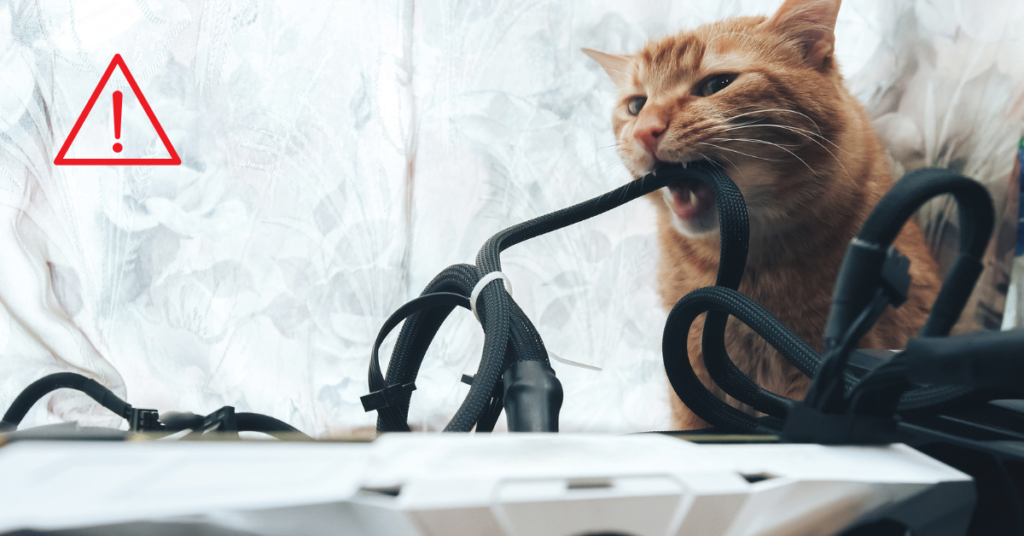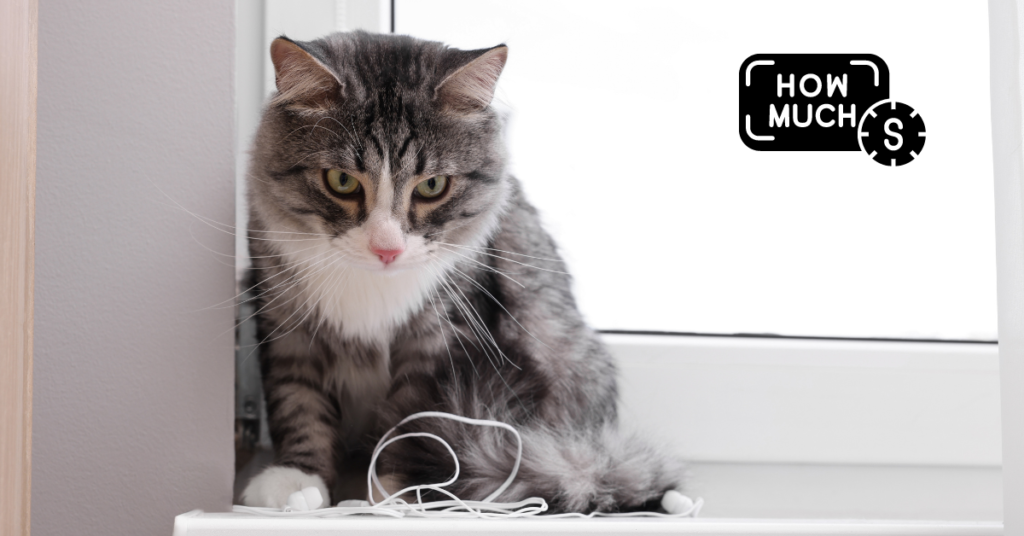My Cat’s Behaviour Bite My Legs?Cats are intriguing animals with special behaviours that frequently take off us astounded. One behaviour b that numerous cat proprietors experience is their cat companion gnawing their legs. If you’re pondering, “Why does my cat’s behaviour chomp my legs?” you’re not alone. This apparently odd behaviour can have a few basic causes, extending from lively tricks to more genuine issues. In this comprehensive direct, we’ll investigate the reasons behind this behaviour and offer down to earth arrangements to address it.
Common Reasons Why Cats Chomp Legs

Understanding why your cat nibbles your legs begins with recognising the common causes behind this behaviour. Here’s a closer see at a few of the most visit reasons:
1. Energy and Chasing Instincts
Cats are characteristic seekers and their intuitive to jump and chomp is profoundly imbued. When a cat nibbles your legs, it might be treating them as a target for play. This behaviour is particularly common in more youthful cats and cats, which have more vitality and less control over their play aggression.
It sounds like you’re interested in how liveliness and chasing instinctual might be related. In numerous creatures, especially predators like cats and mutts, liveliness is closely connected to their chasing instinctual. For example:
- Skill Advancement: Play regularly imitates chasing behaviours. Cats and puppies will stalk, jump, and “capture” toys, which makes a difference them create the aptitudes they’ll require for genuine hunting.
- Energy Outlet: Play gives a way for creatures to burn off abundance vitality, which can be critical for keeping up physical and mental well being. For predators, this is particularly critical since a need of physical movement can affect their capacity to chase effectively.
- Social Interaction: In species that chase in packs or bunches, play can too serve as a way to reinforce social bonds and hone agreeable chasing strategies.
key takeaways My Cat’s Behaviour Bite My Legs?
- Liveliness: Cats regularly nibble amid play. If your cat is youthful or has a part of vitality, it might be locks in in lively behaviour.
- Attention-Seeking: Your cat might be attempting to get your consideration. If they take note that gnawing leads to interaction, they may rehash the behaviour to get noticed.
- Over stimulation: Now and then, a cat might chomp if it’s overstimulated amid petting or play. Pay consideration to their body dialect for signs that they’re getting to be overstimulated.
- Boredom: Cats require mental and physical incitement. If they’re bored, they might resort to gnawing as a way to engage themselves.
- Aggression or Fear: If the gnawing appears forceful or is went with by cautious body dialect, your cat might be feeling debilitated or on edge.
How Perkiness Leads to Leg Biting
In the wild, cats utilise their paws and teeth to capture prey. Household cats hold these instinctual, and leg gnawing can be a way for them to reenact chasing behaviour. If your cat is gnawing your legs amid recess, it might basically be locks in in a shape of “chasing practice.”
Playfulness can in some cases lead to leg gnawing, especially in youthful creatures like puppies or cats. Here’s how it by and large happens:
- Exploration: Puppies and cats investigate their world through their mouths. Gnawing is a characteristic portion of their play and learning handle. When they nibble, they’re testing their environment and learning almost surfaces and sensations.
- Attention-Seeking: Some of the time, gnawing can be a way for a perky creature to get consideration. If they take note that gnawing leads to a response, they might proceed doing it to lock in with their human companions.
- Energy Outlet: Lively behaviour is moreover a way for creatures to exhaust abundance vitality. Gnawing and running around can offer assistance them burn off a few of their tall vitality levels.
2. Attention-Seeking Behaviour
Another reason why your cat’s behaviour might include gnawing your legs is attention-seeking. Cats regularly utilise diverse strategies to get their owners’ consideration, and leg gnawing is one way they might express this need.
Attention-seeking behaviour alludes to activities individuals take to pick up consideration from others, frequently to fulfil enthusiastic or mental needs. This behaviour can show in different ways, such as talking uproariously, hindering discussions, or performing sensational actions.
Here are a few common reasons why individuals might lock in in attention-seeking behaviour:
- Validation: They might look for confirmation and acknowledgement from others to boost their self-esteem.
- Loneliness: If somebody feels separated or dismissed, they might act out to feel connected.
- Unmet Needs: It can be a way to express neglected passionate or mental needs.
- Insecurity: Individuals who feel uncertain might look for consideration to compensate for their need of confidence.
- Pattern of Behaviour: For a few, attention-seeking can be a learned behaviour or a portion of their personality.
Table for My Cat’s Behaviour Bite My Legs?
| Reason for Behaviour | Description | Possible Solutions |
|---|
| Playful Behaviour | Cats, especially young ones, often bite during play as a form of hunting practice. | Engage your cat with interactive toys; provide plenty of playtime. |
| Over stimulation | Cats may bite when they are overstimulated or overexcited. | Monitor play sessions and stop if your cat shows signs of over stimulation. |
| Attention-Seeking | Your cat might be biting to get your attention or because it wants something. | Ensure your cat has a consistent routine and adequate mental stimulation. |
| Affection | Some cats show affection through gentle biting or nibbling. | Observe the context of the bites; if they are gentle, it might be a sign of affection. |
| Stress or Anxiety | Changes in the environment or routine can lead to stress-related behaviours. | Provide a stable environment and consider using calming products or pheromone diffuses. |
| Medical Issues | Pain or discomfort might cause a cat to bite as a way of expressing distress. | Consult with a veterinarian to rule out any health issues. |
| Territorial Behaviour | Cats may bite to assert dominance or mark their territory. | Ensure your cat has its own space and isn’t feeling threatened by other pets or changes in the home. |
How to Address Attention-Seeking Bites

If your cat is gnawing your legs to get your consideration, it’s imperative to react fittingly. Attempt to lock in your cat with intelligently toys or assigned recess. This can offer assistance divert their centre absent from gnawing your legs and towards more satisfactory activities.
To address attention-seeking nibbles, to begin with, maintain a strategic distance from responding with fervour or outrage, as this may fortify the behaviour. Divert your pet’s enter a toy or a positive action when they nibble. Reliably utilise commands like “no” or “ouch” in a firm but calm voice. Give plentiful work out and mental incitement to diminish boredom. Strengthen positive behaviour with rewards and consideration, guaranteeing they get it that gnawing isn’t a way to get attention.
3. Over stimulation or Over excitement
Sometimes, cats chomp when they gotten to be over stimulated or excessively energised. This is especially common in circumstances where they are pet or played with as well vigorously.
Both over stimulation and over excitement include increased states of enthusiastic or tangible movement, but they contrast in setting and impact:
- Over stimulation: This ordinarily alludes to an overpowering sum of tactile input or enthusiastic push that can lead to distress or trouble preparing data. It’s regularly related with situations that are as well loud, shinning, or chaotic, driving to sentiments of being overwhelmed.
Recognising Over stimulation
Over stimulation can lead to a sudden nibble as a way for your cat to flag that they require a break. See for signs such as jerking tails, expanded understudies, or sudden shifts in behaviour. Recognising these signs can offer assistance you anticipate over stimulation and the consequent leg biting.
Recognising over stimulation includes paying consideration to both physical and passionate signs that you or somebody else may be encountering an over-burden of tangible or cognitive input. Here are a few key indicators:
1.Physical Symptoms
- Headaches or headaches: A common reaction to as well much tangible input.
- Fatigue: Feeling abnormally tired or depleted, indeed after resting.
- Muscle pressure: Taking note snugness or distress in the body.
- Restlessness or disturbance: Trouble sitting still or feeling a sense of unease.
2.Emotional Symptoms
- Irritability or dissatisfaction: Getting to be effectively irritated or disturbed by minor issues.
- Overwhelm: Feeling like you can’t handle everything that’s happening around you.
- Anxiety or freeze: Encountering expanded stress or a sense of looming doom.
3.Cognitive Symptoms
- Difficulty concentrating: Battling to centre on errands or thoughts.
- Memory issues: Absent mindedness or inconvenience reviewing information.
- Decision weakness: Finding it difficult to make choices or decisions.
4.Behavioural Symptoms
- Withdrawal: Dodging social intelligent or looking for solitude.
- Increased affect ability: Getting to be excessively delicate to clamours, lights, or other stimuli.
4. Push or Anxiety
Cats are delicate creatures and changes in their environment can cause stretch or uneasiness. This push can show in different ways, counting biting.
Stress and uneasiness are related but unmistakable experiences:
Stress ordinarily comes about from outside weights or requests, like work due dates or relationship issues. It’s frequently a reaction to a particular circumstance or challenge and tends to lessen once the stressors is evacuated or resolved.
Anxiety, on the other hand, is more inside and can hold on indeed without a prompt outside cause. It includes intemperate stress or trepidation that can be more generalised or unavoidable, regularly affecting every day functioning.
Identifying Push Triggers
Changes in the family, such as moving, unused pets, or changes in schedule, can contribute to a cat’s stretch. If your cat’s leg gnawing coincides with these changes, tending to the stressors might diminish the behaviour.
How to Oversee and Adjust Leg Gnawing Behaviour

Once you’ve distinguished why your cat nibbles your legs, it’s time to take steps to oversee and adjust this behaviour. Here are a few methodologies to offer assistance you address leg biting:
1. Divert Their Attention
If your cat chomps your legs due to liveliness or boredom, divert their vitality towards suitable toys. Intelligently toys, like quill wands or laser pointers, can give your cat with a fulfilling outlet for their ruthless instincts.
Certainly! To divert someone’s consideration viably, you might attempt these strategies:
- Introduce a Unused Theme: Delicately control the discussion towards something else that is curiously or significant. For illustration, “Talking of that, have you listened approximately the most recent news in [topic]?”
- Ask a Address: Lock in them with a address almost a distinctive subject. This can move their centre and possibly open up modern roads for dialog. For occasion, “What are your contemplation on [modern topic]?”
- Offer a Arrangement: If the current theme is causing dissatisfaction or pressure, propose a arrangement or elective movement. For illustration, “Why don’t we take a break and [propose an activity]?”
- Provide a Compliment or Positive Criticism: Highlight something positive to make a more wonderful climate. “I truly appreciate how you taken care of that circumstance. By the way, have you seen [curiously truth or news]?”
- Use Humour: A well-placed joke or light-heated comment can move the disposition and divert centre. Fair make beyond any doubt it’s suitable for the situation.
2. Utilise Positive Reinforcement
Encourage positive behaviour by fulfilling your cat when they play pleasantly or halt gnawing your legs. Treats, laud, and petting can strengthen the behaviour you need to see. Dodge utilising discipline, as it can increment push and compound the problem.
Absolutely! Positive support is all approximately empowering and strengthening great behaviour by advertising something fulfilling. If you’re looking for an illustration, here’s how you might apply it:
- Scenario: Envision you’ve completed a challenging errand at work, and your supervisor needs to utilise positive support to recognise your effort.
- Response: “You did a phenomenal work on that venture! Your consideration to detail and difficult work truly paid off. As a thank you, we’re giving you a reward and an additional day off following week. Keep up the incredible work!”
3. Build up a Routine
A steady schedule can offer assistance decrease push and uneasiness in cats. Guarantee your cat has customary bolstering times, playtime, and a calm environment. This consistency can offer assistance your cat feel more secure and less likely to show stress-related behaviours.
Certainly! Setting up a schedule can significantly upgrade efficiency and well-being. Here’s a straightforward direct to offer assistance you get started:
- Identify Your Objectives: Decide what you need to accomplish with your schedule. It might be way better time administration, expanded efficiency, or more adjusted work-life integration.
- Choose Key Exercises: Select the exercises that are basic for coming to your objectives. This might incorporate work out, work assignments, supper times, and relaxation.
- Set Particular Times: Dole out particular times for each action. For case, arrange to work out at 7 AM, begin work at 9 AM, and loosen up at 8 PM.
- Prioritise Assignments: Organise your assignments by significance and due dates. Handle high-priority errands when you’re most caution and focused.
- Be Steady: Adhere to your schedule as closely as conceivable. Consistency makes a difference to frame propensities and makes it less demanding to take after through.
4. Give Enrichment
Environmental improvement is vital for keeping your cat rationally and physically fortified. Give scratching posts, climbing trees, and astound toys to keep your cat locked in and decrease the probability of leg biting.
Enrichment includes improving a person’s or organism’s environment to advance well-being and fortify development. In instruction, it implies giving extra assets or exercises to develop understanding and abilities. For creatures, it might incorporate toys or complex situations to energise characteristic behaviours. Improvement can lead to progressed mental well being, inventiveness, and by and large fulfilment. It’s around making openings for advancement and engagement past fundamental needs.
5. Counsel a Veterinarian or Behaviourist
If the leg gnawing holds on or appears to be related to basic well being issues, counsel a veterinarian or a cat behaviourist. They can offer assistance run the show out therapeutic issues and give custom-made counsel for overseeing your cat’s behaviour.
If you’re managing with a circumstance including your pet’s well being or behaviour, it’s vital to counsel a veterinarian for therapeutic issues and a behaviourist for behavioural concerns.
- Veterinarian: If your pet has physical side effects, bizarre behaviour that might demonstrate a well being issue, or if you’re uncertain almost any angle of their physical well-being, a vet is the best asset. They can give a exhaustive examination, analyse issues, and recommend suitable medicines or interventions.
- Behaviourist: If your pet is showing behavioural problems—such as hostility, uneasiness, over the top woofing, or dangerous behaviour—a certified creature behaviourist can offer assistance. They specialise in understanding and adjusting behaviour through preparing and behavioural procedures.
FAQs About My Cat’s Behaviour Bite My Legs?
Q: Is leg gnawing a sign of aggression?
Not essentially. Leg gnawing can be a shape of play or a way to look for consideration. In any case, if the gnawing is gone with by other forceful behaviours, it may be a sign of hostility, and counselings a proficient may be beneficial.
Q: How can I tell if my cat is playing or being aggressive?
Perky gnawing is as a rule tender and went with by other lively behaviours, such as jumping or batting at objects. Forceful gnawing is more commanding and may be gone with by murmuring or snarling. Watching the setting and your cat’s by and large body dialect can offer assistance you separate between play and aggression.
Q: My cat as it were nibbles my legs amid certain times of the day. Why?
Cats may display leg gnawing behaviour amid times when they are more dynamic or when they are looking for consideration. For illustration, if your cat nibbles your legs in the evening, it might be a sign of pent-up vitality or a crave for interaction after a day of being alone.
Q: Can leg gnawing be a sign of a well being issue?
Whereas leg gnawing is regularly related to behavioural components, it’s critical to run the show out well being issues if the behaviour is sudden or ordinary. Conditions such as dental issues or joint torment can some of the time cause a cat to act out in distinctive ways.
Conclusion
Understanding why your cat’s behaviour includes gnawing your legs can offer assistance you address the issue successfully. Whether it’s due to liveliness, attention-seeking, over stimulation, or stretch, recognising the root cause is key to finding an arrangement. By utilising positive fortification, giving enhancement, and keeping up a steady schedule, you can offer assistance oversee and adjust this behaviour. If required, don’t waver to look for counsel from a veterinarian or cat behaviourist to guarantee your cat’s well-being and bliss.
